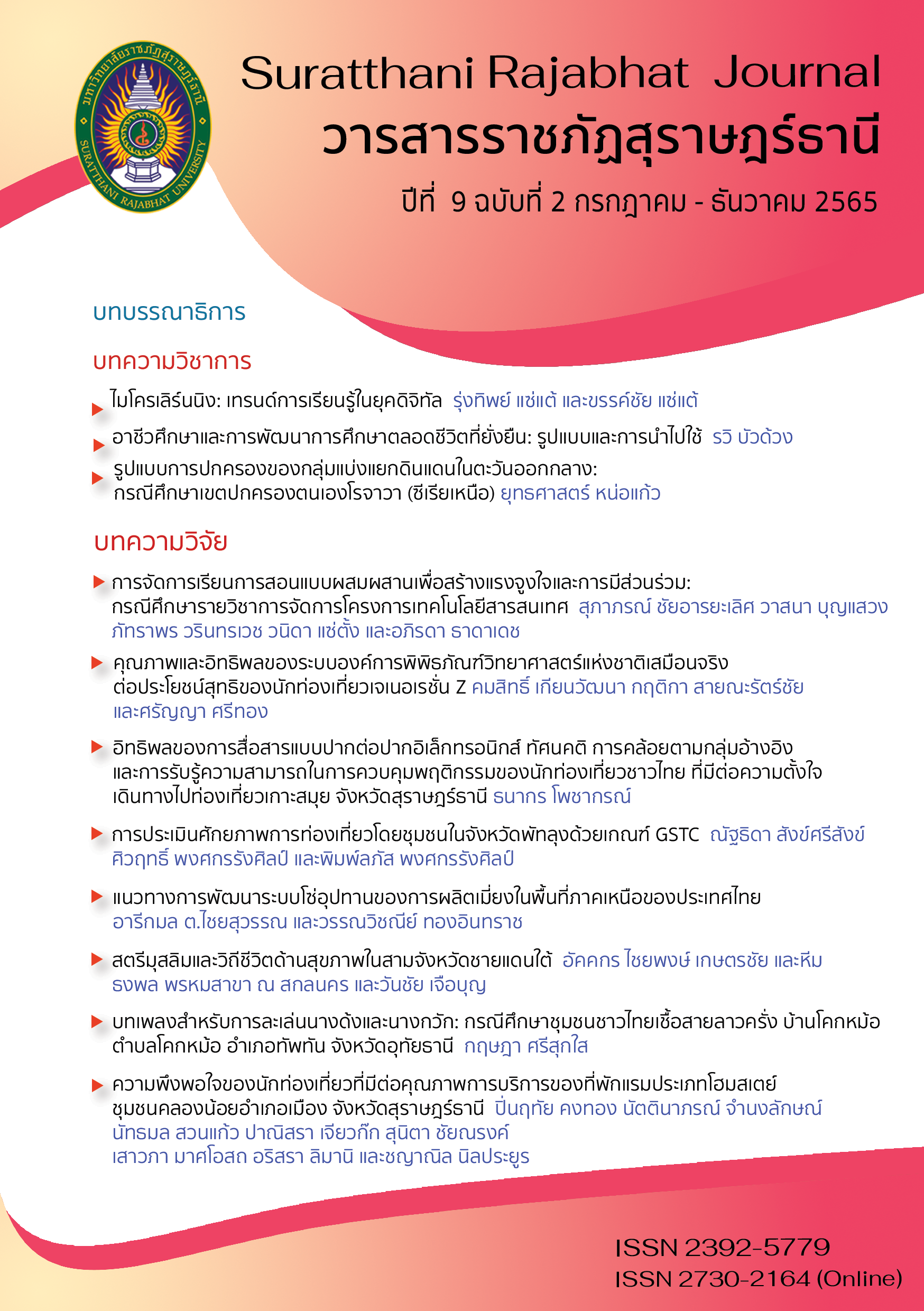Blended Learning Approach for Increasing Learners’ Motivation and Participation: Case Study of Project Management Information Technology Course
Main Article Content
Abstract
The purpose was to 1) study the student learning achievement on the blended learning approach for Information Technology Project Management course; 2) evaluate levels of participation on the blended learning approach; 3) assess the students’ satisfaction towards the blended learning approach of the course. The research sampling group was 14 undergraduate students majoring in Information System at Faculty of Science and Industrial Technology, Prince of Songkla University who enrolled in the Information Technology Project Management course in academic year 2019. The research instruments included 1) teaching plan; 2) Learning Management System (ClassStart); 3) gamification; 4) pre- and post-tests; 5) behavioural observation form on the participation in the blended learning activities; and, 6) assessment form on students’ satisfaction towards the blended learning approach. The data analytical statistics were means, standard deviation and t-test. The findings reveal that 1) the evaluation on effectiveness of the blended learning approach is 79.16/80.00 resulted in the academic achievements of students after participated in the blended learning approach were better than before their participations in the statistical significance of 0.1; 2) the blended learning approach integrated with online game (Kahoot!) has motivational effects to the classroom as it could be seen from in-class participation at 97.62 %; 3) the integration of ClassStart exposes its effect on class attendance in which the percentage of on time is 92.86; and 4) the level of students’ satisfaction in the blended learning approach was high level
Article Details

This work is licensed under a Creative Commons Attribution-NonCommercial-NoDerivatives 4.0 International License.
References
ชไมพร อินทร์แก้ว, และวิชัย นภาพงศ์. (2559). ผลของการจัดการเรียนการสอนแบบผสมผสานรายวิชาเทคโนโลยีทางภาพถ่ายในการศึกษาสำหรับนักศึกษาระดับปริญญาตรีคณะศึกษาศาสตร์ มหาวิทยาลัยสงขลานครินทร์. วารสารวิทยบริการ มหาวิทยาลัยสงขลานครินทร์, 27(2), 29-36.
ชนัตถ์ พูนเดช, และธนิตา เลิศพรกุลรัตน์. (2559). แนวทางการจัดการเรียนรู้ด้วยแนวคิดเกมมิฟิเคชัน. วารสารศึกษาศาสตร์ มหาวิทยาลัยนเรศวร, 18(3), 331-339.
ปรัชญนันท์ นิลสุข, และปณิตา วรรณพิรุณ. (2556) การจัดการเรียนรู้แบบผสมผสาน: สัดส่วนการผสมผสาน. วารสารพัฒนาเทคนิคศึกษา, 25(85), 31-36.
ประภาวรรณ ตระกูลเกษมสุข. (2559). การประยุกต์ใช้รูปแบบการเล่นวิดีโอเกมในการเรียนการสอนที่มีต่อการพัฒนาพฤติกรรมการเข้าชั้นเรียนการมีส่วนร่วมและผลสัมฤทธิ์ทางการเรียนของนักศึกษาระดับปริญญาตรี. การประชุมหาดใหญ่วิชาการระดับชาติและนานาชาติครั้งที่ 7. สงขลา: มหาวิทยาลัยหาดใหญ่.
รุจาภา เพชรเจริญ, และวรสิทธิ์ เจริญศิลป์. (2018). การประเมินการใช้ KahootProgram ในการจัดการเรียนการสอนผ่านเครือข่ายการสอนทางไกล Telemedicine. Journal of Faculty of Education Pibulsongkram Rajabhat University, 5(2), 162-175.
สุสัณหา ยิ้มแย้ม, อำไพ จารุวัชรพาณิชกุล, จันทรรัตน์ เจริญสันติ, อภิรัช อินทรางกูร ณ อยุธยา, ปิยะนุช ชูโต, และนงลักษณ์ เฉลิมสุข. (2558). การพัฒนาการจัดการเรียนรู้แบบผสมผสานเพื่อพัฒนาทักษะการเรียนรู้ในศตวรรษที่ 21. Nursing Journal, 42, 129-140.
สุวัฒน์ นิยมไทย. (2020). การพัฒนาการจัดการเรียนรู้ภาษาอังกฤษแบบผสมผสานโดย ใช้โครงงานและเทคโนโลยีเป็นฐานสำหรับนักศึกษาระดับประกาศนียบัตรวิชาชีพ ชั้นสูงวิทยาลัยเทคนิคสุโขทัย. T-VET Journal, 4(8), 63-84.
ศรัณย์ลิตา โชติรัตน์. (2562). การจัดการเรียนการสอนแบบผสมผสานและการบูรณาการเกมมิฟิเคชั่นกระตุ้นการเรียนรู้ในรายวิชาโครงสร้างข้อมูลและอัลกอริทึม. วารสารวิทยบริการ มหาวิทยาลัยสงขลานครินทร์, 30(2), 69-79.
Allen, I. E., & Seaman, J. (2005). Growing by degrees: Online education in the United States, 2005. Sloan Consortium (NJ1). 2020. http://sloancon sortium.org/resources/growing_by_degrees.pdf.
Anthony, B., Kamaludin, A., Romli, A., Raffei, A. F. M., Phon, D. N. A. E., Abdullah, A., & Ming, G. L. (2020). Blended learning adoption and implementation in higher education: a theoretical and systematic review. Technology, Knowledge and Learning, 27, 531-578.
Banfield, J., & Wilkerson, B. (2014). Increasing Student Intrinsic Motivation And Self-Efficacy Through Gamification Pedagogy. Contemporary Issues in Education Research (CIER), 7(4), 291–298.
Baragash, R. S., & Al-Samarraie, H. (2018). Blended learning: Investigating the influence of engagement in multiple learning delivery modes on students’ performance. Telematics and Informatics, 35(7), 2082-2098.
Bawa, P. (2019). Using Kahoot to inspire. Journal of Educational Technology Systems, 47(3), 373-390.
Buatip, S., Chaivisuthangkura, P., & Khumwong, P. (2019). Enhancing Science Teaching Competency among Pre-Service Science Teachers through Blended-Mentoring Process. International Journal of Instruction, 12(3), 289-306.
Dziuban, C., Graham, C. R., Moskal, P. D., Norberg, A., & Sicilia, N. (2018). Blended learning: the new normal and emerging technologies. International journal of educational technology in Higher education, 15(1), 1-16.
Eagleton, S. (2017). Designing blended learning intervention for the 21st century student. Adv Physiol Edu, 41, 203-211.
Goksun, D. O., & Gursoy, G. (2019). Comparing success and engagement in gamified learning experiences via Kahoot and Quizizz. Computers & Education, 135, 15-29.
Graham, C. R., Henrie, C. R., & Gibbons, A. S. (2013). Developing models and theory for blended learning research. Blended learning: Research perspectives, 2, 13-33.
Ismail, M. A.-A., & Mohammad, J. A.-M. (2017). Kahoot: A Promising Tool for Formative Assessment in Medical Education. Education in Medicine Journal, 9(2), 19–26.
Licorish, S. A., Owen, H. E., Daniel, B., & George, J. L. (2018). Students’ perception of Kahoot!’s influence on teaching and learning. Research and Practice in Technology Enhanced Learning, 13(1), 1-23.
Plump, C. M., & LaRosa, J. (2017). Using Kahoot! in the classroom to create engagement and active learning: A game-based technology solution for eLearning novices. Management Teaching Review, 2(2), 151-158.
Rasheed, R. A., Kamsin, A., & Abdullah, N. A. (2020). Challenges in the online component of blended learning: A systematic review. Computers & Education, 144, 103701.
Kuo, M. S., & Chuang, T. Y. (2016). How gamification motivates visits and engagement for online academic dissemination - An empirical study. Computers in Human Behavior, 55, 16–27.
Spence, B. (2019). The Effects of Interactive Quizzing with Kahoot! on Student Learning and Satisfaction: A Pilot Study. Radiologic Science & Education, 24(2), 21-28.
Wang, A. I., & Lieberoth, A. (2016). The Effect of Points and Audio on Concentration, Engagement, Enjoyment, Learning, Motivation, and Classroom Dynamics Using kahoot!. In Proceedings of the European Conference on Games-based Learning (pp. 738–746).
Wash, P. D. (2014). Taking advantage of mobile devices: Using Socrative in the classroom. Journal of Teaching and Learning with Technology, 3(1),99–101.


